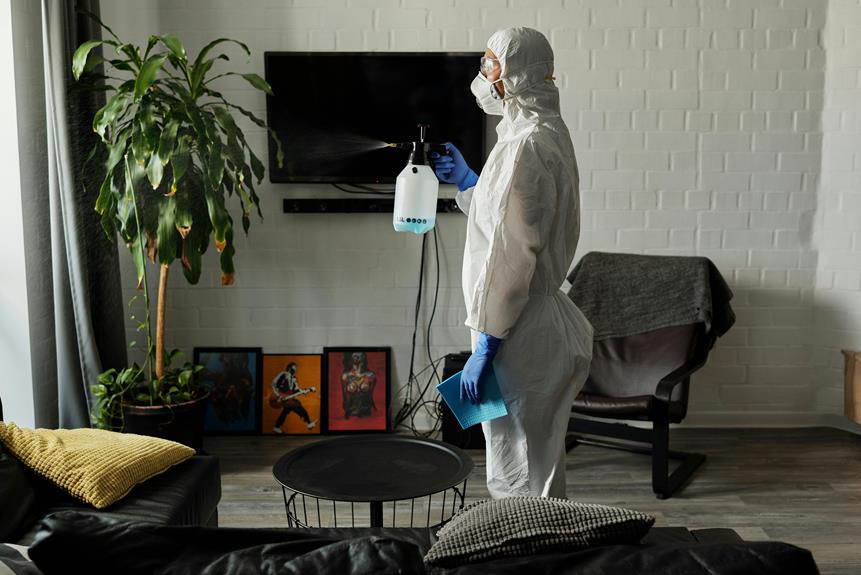Lets get straight to it. How To check if TV aerial is working? Start with a visual inspection for damages like corrosion or bent elements.
Confirm that metal components are intact, and no obstructions block the signal path. Validate that all cable connections are secure and check the coaxial cable for wear or corrosion.
Retune your television via the settings menu, initiating a channel scan to evaluate signal strength. Connecting the aerial to another TV can help isolate the issue.
Finally, examine the signal strength indicator in your TV’s settings to assess reception quality.
These steps will guide you towards ensuring peak aerial performance.
Key Information
- Inspect the TV aerial for physical damage or corrosion.
- Verify all cable connections between the TV and aerial are secure and undamaged.
- Retune the television by initiating a channel scan in the settings menu.
- Test the aerial with another TV to determine if the issue lies with the original TV or aerial.
- Check the signal strength indicator in the TV’s settings to evaluate reception quality.
Visual Inspection
Begin by inspecting your TV aerial for any physical damages such as corrosion, cracks, or bent elements that could compromise its functionality.
Use a ladder to safely access the aerial and perform a thorough visual inspection. Pay close attention to the integrity of the metal components.
Corrosion can cause signal degradation, so look for rust spots or corrosion. Bent elements may not align properly, affecting the signal reception.
Additionally, survey the surroundings for any obstructions like tall trees or buildings that might block the signal path between the aerial and the transmitter.
Confirm there’s a clear line of sight from the aerial to the transmitter, as obstacles can significantly reduce signal strength and quality.
Check Connections
After confirming the aerial’s physical condition,
the next step is to verify that all cable connections between the TV and the aerial are securely plugged in and free of any visible damage.
Inspect the coaxial cable for any signs of wear, such as fraying or cuts. Examine the connectors closely for corrosion or rust, which can greatly degrade signal quality.
Make sure the coaxial cable is firmly inserted into the TV’s RF input. To isolate the issue, test the setup with a different, known-working coaxial cable.
This helps determine if the problem lies with the cable itself.
Properly secured and undamaged connections are essential for optimal signal transmission, so don’t overlook this step.
Retune Television
To fine-tune your television, access the settings menu and initiate a channel scan to guarantee the best reception of all available channels.
Navigate to the ‘Settings’ or ‘Menu’ option on your remote control, then select ‘Channel Setup’ or ‘Tuning’.
Choose ‘Auto-Tune‘ or ‘Auto-Scan’ and follow the on-screen prompts to start the scanning process. This will make certain that your TV detects and stores all available channels with peak signal strength.
During the scan, monitor the signal strength indicator, usually found in the tuning settings. This provides real-time feedback on the quality of the signal received.
Clear reception across channels indicates a properly functioning TV aerial. If signal levels are weak, further troubleshooting may be required.
Test With Another TV
If retuning your television hasn’t resolved the issue, connect the TV aerial cable to another TV to ascertain whether the problem originates from the original TV or the aerial system itself.
Testing with another TV is a straightforward method to verify signal integrity. By doing this, you can quickly determine if the fault lies within the TV’s tuner or the aerial wiring.
| Step | Action | Result |
|---|---|---|
| 1. | Disconnect aerial from original TV | Prevent interference |
| 2. | Connect aerial to another TV | Begin testing process |
| 3. | Scan for channels | Assess signal reception |
| 4. | Compare results | Identify source of problem |
If the spare TV shows clear channels, the original TV might be faulty. This method doesn’t require specialized tools, making it efficient for troubleshooting.
Examine Signal Strength
Navigate to your TV’s settings menu to access the signal strength indicator and evaluate the quality of your aerial reception.
Look for the signal strength section, often found under ‘Channel Setup‘ or ‘Tuner Settings.’ Once located, the indicator will display levels ranging from weak to strong, providing real-time feedback.
If the signal strength is weak, it could indicate issues with your TV aerial setup, necessitating further troubleshooting. Analyze the data to identify any potential problems affecting functionality.
Use this information to diagnose and rectify reception issues, potentially adjusting the aerial’s position or securing connections.
Monitoring signal strength is essential for optimizing your TV viewing experience, ensuring clear and uninterrupted broadcasts.
Frequently Asked Questions
How Do I Test My TV Aerial?
First, visually inspect the aerial for damages and alignment. Check all connections and cables for wear. Retune your TV via settings. Connect another TV to the aerial. Finally, assess the signal strength indicator in the TV settings.
Why Is My TV Not Picking up Aerial Signal?
Your TV might not pick up the aerial signal due to loose connections, cable corrosion, or physical damage. Inspect the coax plug, check for water ingress, and make sure the TV is set to the correct input.
How to Check if a TV Antenna Is Working?
Visually inspect the aerial for damages and proper alignment. Check connections for security and integrity. Retune your TV by accessing settings. Test with another TV. Use the signal strength indicator in settings for real-time feedback.
How Do I Know if My TV Aerial Needs Replacing?
You should inspect for visible damage like corrosion or cracks on the TV aerial. Check connections and aerial cables for issues. If reception problems persist, even after troubleshooting, it’s likely time to replace your TV aerial.
Conclusion
To guarantee your TV aerial is functioning properly its important to know how to check if TV aerial Is working: start with a visual inspection for any visible damage. Check all connections are secure and free from corrosion.
Retune your television to update channels. If issues persist, test the aerial with another TV to rule out a faulty set.
Finally, examine the signal strength using your TV’s built-in diagnostics or a signal meter. By systematically following these steps, you can effectively troubleshoot and resolve most aerial issues.



